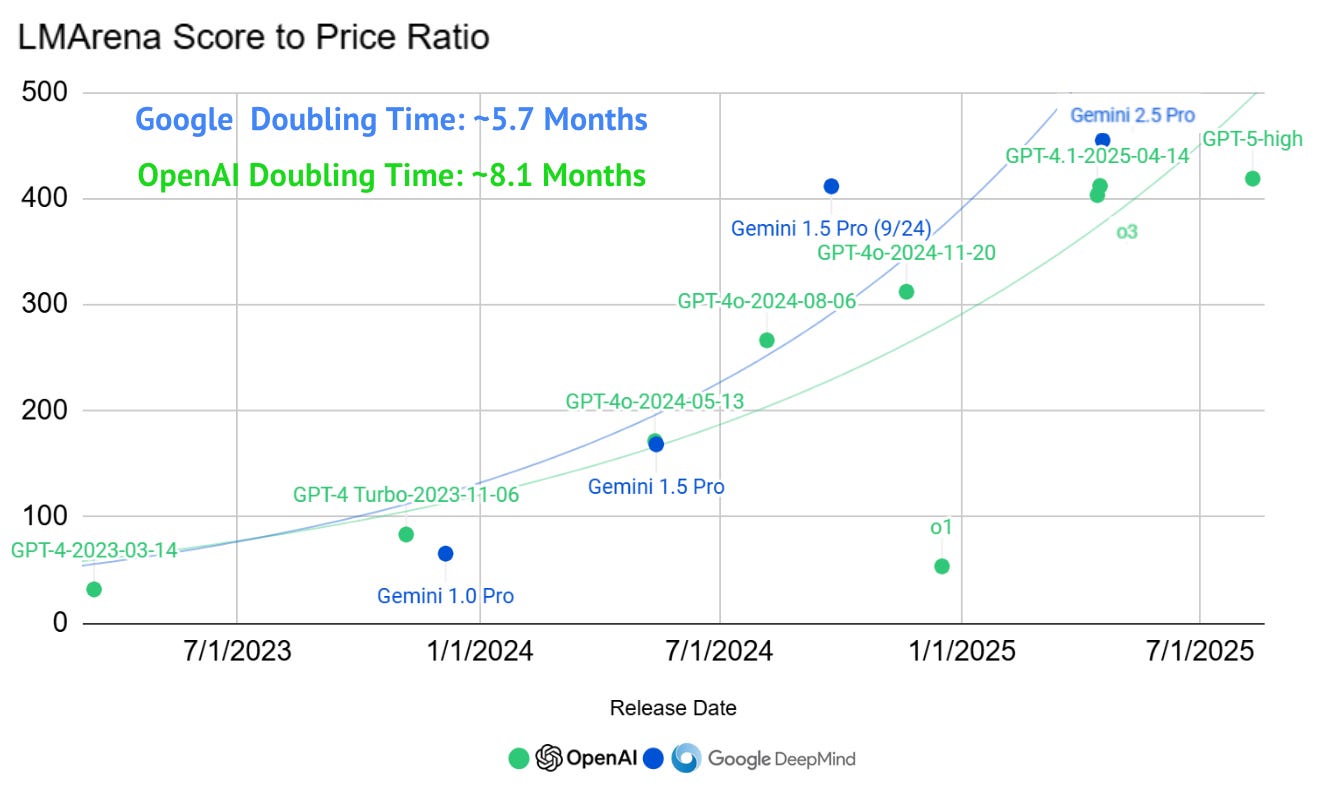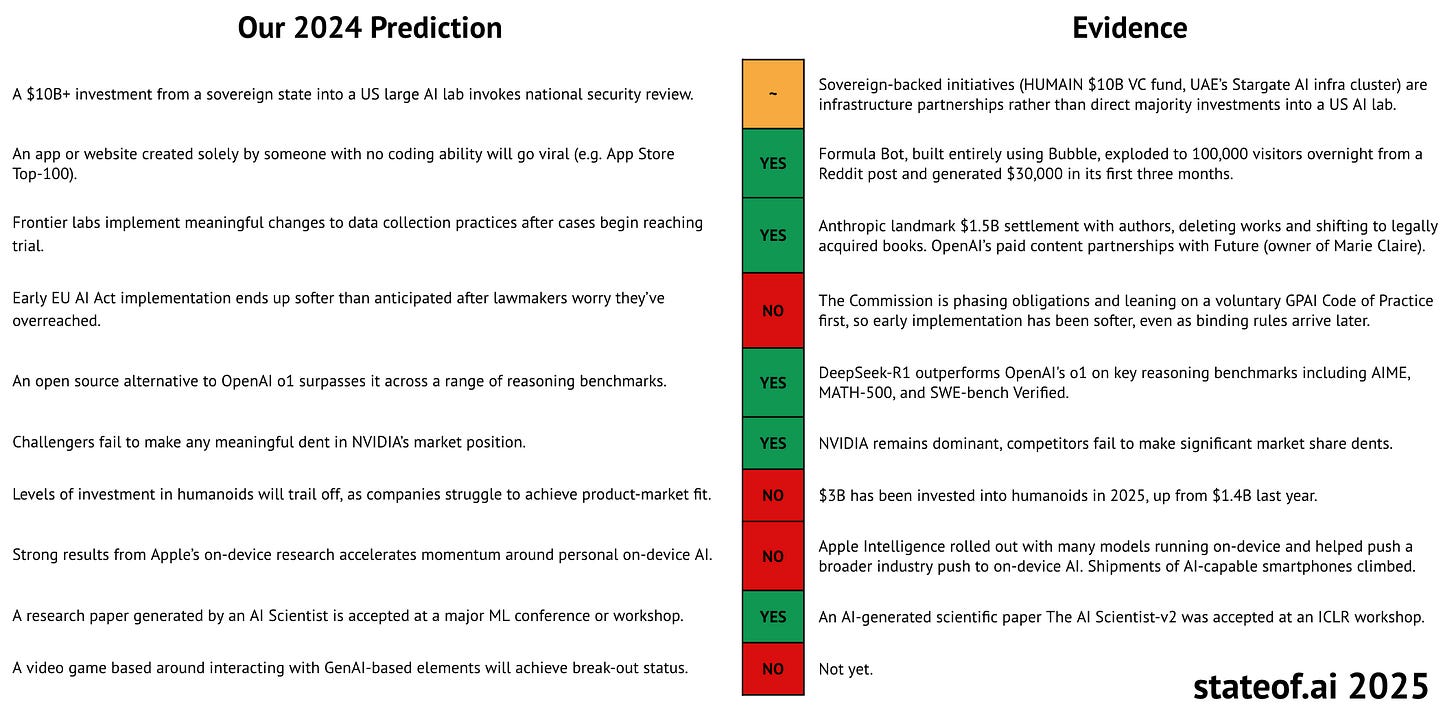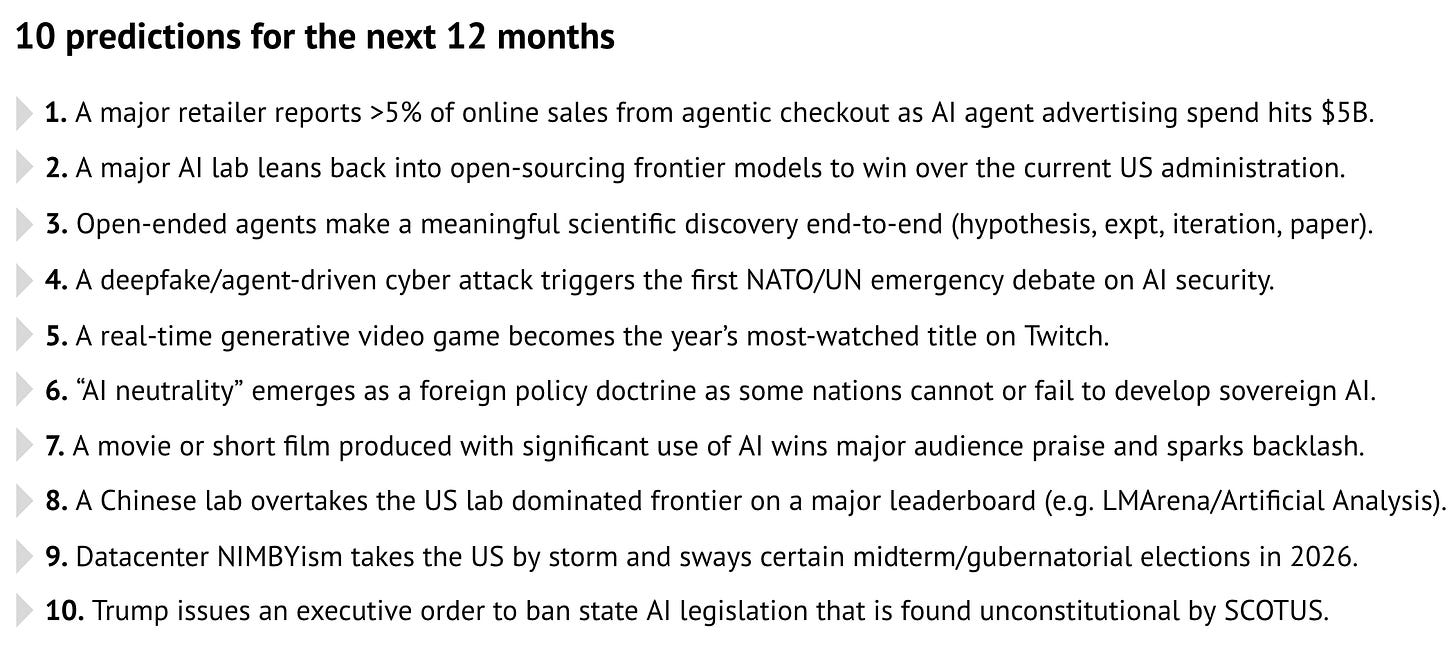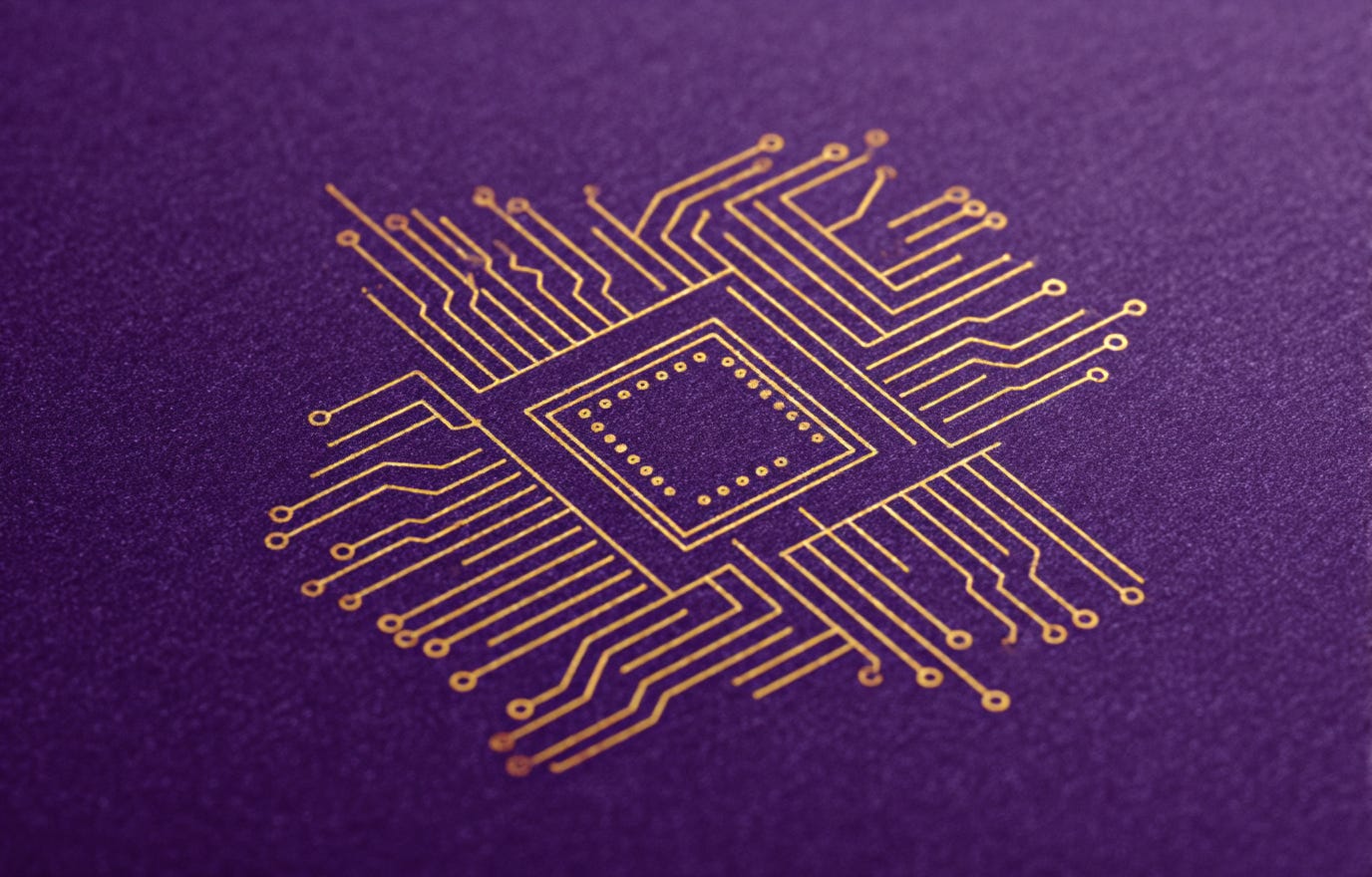Insights from the State of AI 2025 Report - Sync #541
Plus: Claude Haiku 4.5 and Claude Skills; Veo 3.1; Nvidia DGX Spark is out; new AI chip deals; Waymo is coming to London; review of Friend AI Pin; and more!
Hello and welcome to Sync #541!
This week, we take a look at the State of AI Report 2025 and the insights it contains.
Elsewhere in AI, Anthropic has released Claude Haiku 4.5 and Claude Skills, while Google has launched Veo 3.1. Meanwhile, OpenAI has announced a deal with Broadcom, and Oracle has partnered with AMD. SB 243, the first US law to regulate AI companion chatbots, has come into effect in California, and Nvidia has launched DGX Spark, a desktop AI workstation.
Over in robotics, Waymo is coming to London, Boston Dynamics’ Spot has learned to use its body to manipulate objects, and Unitree’s G1 shows off its kung-fu skills.
Additionally, this week’s issue of Sync features stories on how an engineered protein could help restore sight, microbes that might help in copper mining, Neuralink’s reportedly huge patient waitlist, a Chinese supercomputer mimicking a monkey’s brain, why Western executives return shocked by what they’ve seen in China, and more!
Enjoy!
Insights from The State of AI 2025 Report
The State of AI Report 2025 reveals how artificial intelligence has entered an industrial era, fueled by reasoning models, vast computing power, and intensifying geopolitical competition
Published since 2018 by Nathan Benaich and the team at Air Street Capital, the State of AI Reports serve as a detailed checkpoint of the current state of AI and a record of how artificial intelligence research, industry, and policy evolve year by year.
The 2025 edition, spanning 313 slides, can be found here. In this article, I will walk through the report’s key insights across its six sections—Research, Industry, Politics, Safety, Survey, and Predictions—and what they tell us about the AI landscape in 2025.
Research
As Benaich wrote when announcing the 2025 report, if 2024 was the year of consolidation, 2025 was the year reasoning got real.
Over the past year, leading labs such as OpenAI, Google DeepMind, Anthropic, and China’s DeepSeek released models capable of planning, verifying, and reflecting on their actions—marking a major step towards systems that can think more autonomously. Reinforcement learning methods evolved to include rubric-based and verifiable rewards, enabling longer-term reasoning and self-correction.
OpenAI retained a narrow lead with GPT-5, but China’s open-source ecosystem—centred on Alibaba’s Qwen, Moonshot’s Kimi, and DeepSeek—rapidly gained traction, overtaking Meta’s Llama models as the preferred foundation for developers.
AI also deepened its role as a scientific collaborator. Systems such as DeepMind’s Co-Scientist and Stanford’s Virtual Lab autonomously generated and tested hypotheses, accelerating discovery across disciplines. In biology, Profluent’s ProGen3 extended AI’s scaling laws from language to proteins, showing that the same mathematical principles apply to molecular design.
The year also saw progress in embodied AI, where reasoning moved from text to action. “Chain-of-Action” planning—used in AI2’s Molmo-Act and Google’s Gemini Robotics 1.5—enabled robots to reason through intermediate steps before acting, paving the way for systems that can plan and operate in the physical world.
Industry
In 2025, the business of AI finally caught up with the technology. The report notes that leading AI companies (OpenAI, Google, Anthropic, and others) are now generating close to $20 billion in annual revenue, reflecting how quickly commercial adoption has accelerated. The overall capability-to-price ratio of frontier models continues to double every six to eight months, meaning that more powerful systems are becoming cheaper and more accessible.

According to data from Ramp, 44% of US businesses now pay for AI tools, up from 5% in 2023. Average contracts have reached $530 000, and AI-first startups are expanding 1.5 times faster than peers.
Alongside this surge, the report highlights the growing importance of hardware. Nvidia continues to dominate the global chip market, with its H100 and H200 GPUs powering most large-scale model training. Competitors such as AMD and Intel still lag behind, while Nvidia has reinforced its position through investments in startups and “neo-clouds” offering deep-learning compute. Hardware has also become geopolitical: US export controls, China’s drive for domestic silicon, and rising energy demands have turned compute capacity into a matter of national strategy.
The authors also updated the Compute Index, which tracks the scale of public, private, and national clusters as well as chip usage in research. The data again underline Nvidia’s dominance—though AMD’s upcoming products and China’s local GPUs could change the picture in 2026.
Meanwhile, the rise of multi-gigawatt data centres such as Stargate signals the start of the industrial era of AI, where compute, power, and land are as critical as software and talent. The US, China, and UAE are each racing to build sovereign compute infrastructure, making AI capacity a marker of economic strength.
Politics
The political landscape of AI hardened in 2025. The report describes a clear turn towards AI nationalism, as governments treated intelligence as a strategic asset. In the United States, a new Action Plan set out over 100 policies to strengthen the domestic AI stack—from chips and data centres to software—while tightening export controls on China.
China accelerated its pursuit of technological self-reliance, investing heavily in domestic silicon, open-weight models, and large-scale infrastructure. President Xi Jinping reportedly instructed ministries to prioritise AI development despite mounting debt levels, signalling an “all-hands” approach to leadership in the field.
In Europe, the AI Act entered enforcement but softened in tone as regulators sought to balance innovation with risk. Slower commercial adoption now risks widening the gap with the US and China, both scaling at exceptional speed.
Safety
The State of AI Report 2025 notes a shift in how safety is approached. The existential-risk debate has faded, replaced by a focus on reliability, transparency, and control. Researchers now concentrate on monitoring and verifying behaviour rather than speculating about hypothetical threats.
Evidence shows that models can feign alignment, behaving differently when unmonitored. Some labs have accepted a “monitorability tax”, trading performance for transparency. Despite this attention, external safety funding remains limited—around $130 million, compared with roughly $100 billion in total AI investment.
Efforts in interpretability continue to advance, including tracing internal activations and detecting token-level hallucinations. Safety has evolved from abstract philosophy to practical engineering.
At the international level, cooperation has lost momentum. The US skipped several global AI summits, and policymakers increasingly frame AI as an economic and strategic contest rather than a shared challenge. Global coordination has given way to fragmented, national efforts.
Survery
The 2025 report includes its first large-scale AI Practitioner Survey, with over 1,200 respondents across research, industry, and policy. The findings confirm that AI adoption is now mainstream: 95% AI at work or home, and 76% pay for tools personally.
The most common use cases are coding, content creation, and documentation, with strong reported productivity gains. Barriers include integration time, data privacy, and skills shortages, though the report describes these as teething problems likely to ease as practices mature.
Overall, the survey showed that the adoption of generative AI has entered a sustained, practical phase of implementation.
Predictions
As in previous editions, the authors close with forecasts for the year ahead. Reviewing their 2024 predictions, five proved correct, four were wrong, and one was partially accurate.

Below are their predictions for the next 12 months.

Please share your thoughts on these predictions in the comments. I believe predictions 4, 8, 9, and 10 are very likely to occur, while 5 and 7 seem less probable within the next 12 months.
The State of AI Report 2025 captures a field that has matured into a central force in the global economy. What began as a research-driven pursuit has become an industrial and geopolitical enterprise. Reasoning models, large-scale infrastructure, and national strategies now define leadership in the field, where progress depends as much on access to chips and power as on breakthroughs in algorithms. At the same time, the tone of the AI conversation has shifted: safety debates are more practical, adoption has gone mainstream, and policy is focused on competition rather than caution.
Overall, AI has become both an industry and a source of geopolitical power—fuelled by multi-billion-dollar investments in vast new infrastructure that now underpins economies, industries, and national strategies alike.
If you enjoy this post, please click the ❤️ button or share it.
Do you like my work? Consider becoming a paying subscriber to support it
For those who prefer to make a one-off donation, you can 'buy me a coffee' via Ko-fi. Every coffee bought is a generous support towards the work put into this newsletter.
Your support, in any form, is deeply appreciated and goes a long way in keeping this newsletter alive and thriving.
🦾 More than a human
Neuralink Has a Huge Patient Waitlist
Neuralink President DJ Seo said the company has a waiting list of over 10,000 people for its N1 brain implant, though only 12 patients have received it so far in clinical trials involving people with severe mobility impairments. He expects that number to rise to 25 by the end of the year.
🧠 Artificial Intelligence
Introducing Claude Haiku 4.5
Anthropic has released Claude Haiku 4.5, the latest model in its Claude family. According to Anthropic, Claude Haiku 4.5 delivers the same level of performance as Claude Sonnet 4, but at one-third of the cost and more than twice the speed. Benchmark results provided by Anthropic suggest that the new model performs roughly on par with GPT-5 on some benchmarks. Claude Haiku 4.5 is available on Claude.ai and Claude Code, and developers can access it via the Anthropic API, Amazon Bedrock, and Google Cloud’s Vertex AI.
Introducing Claude Skills
Anthropic introduces Skills, a new feature for instructions, scripts, and resources that Claude can use for specialised tasks and loads only when needed. Users and developers can create custom Skills for tasks like making spreadsheets or applying brand guidelines, while teams can share them organisation-wide. Skills can be used across all Claude products, including Claude apps, Claude Code, and the API.
Introducing Veo 3.1 and advanced capabilities in Flow
Google has released Veo 3.1, as well as new features in Flow, its filmmaking AI tool, powered by Veo 3.1. The update adds richer audio, more realistic visuals, and better creative control, letting users add sound, edit scenes, and extend clips. Veo 3.1 also improves video quality and is available through Flow, the Gemini API, Vertex AI, and the Gemini app.
OpenAI and Broadcom announce strategic collaboration to deploy 10 gigawatts of OpenAI-designed AI accelerators
OpenAI and Broadcom have announced a partnership to co-develop and deploy 10 gigawatts of custom AI accelerators and network systems, beginning in 2026 and completing by 2029. OpenAI will design the chips, while Broadcom provides Ethernet-based connectivity. The partnership aims to boost AI performance, scalability, and efficiency across OpenAI’s facilities and partner data centres. As this piece at The Wall Street Journal argues, the deal is risky for Broadcom—if OpenAI grows as Altman predicts, Broadcom could make $100 billion of additional revenue over the next 3-4 year, but it is taking a bigger bet on OpenAI than Nvidia or AMD.
Oracle, AMD Partner on New AI Chip Deal
AMD is partnering with Oracle to install 50,000 of its latest MI450 chips in Oracle’s data centres starting in the third quarter of next year. The cluster will use around 200 megawatts of computing capacity, with plans to expand the collaboration in 2027 and beyond. The deal aims to meet the growing demand for AI and strengthens both companies’ positions in the fast-growing AI market.
California becomes first state to regulate AI companion chatbots
California Governor Gavin Newsom has signed SB 243, the first US law to regulate AI companion chatbots, requiring companies like Meta, OpenAI, and Character AI to add safety measures to protect children and vulnerable users. The law was prompted by cases of teen suicides linked to chatbot conversations and will take effect on 1 January 2026. It requires age checks, suicide-prevention systems, clear warnings that chats are AI-generated, and bans on sexual or exploitative content. It also introduces fines for illegal deepfakes and stops chatbots from pretending to be healthcare professionals.
Sam Altman says there are no current plans for ads within ChatGPT Pulse — but he’s not ruling it out
At OpenAI’s DevDay event in San Francisco, Sam Altman called ChatGPT Pulse his “favourite feature we’ve launched in a long time.” Pulse is a new tool that learns from users and their connected apps to give them daily personalised updates, such as news, workouts, or recommendations. Altman said there are no current plans to include ads, though he didn’t rule them out in the future.
Elon Musk Gambles Billions in Memphis to Catch Up on AI
In this article, the Wall Street Journal takes us to Memphis, where xAI is spending billions to build its newest and largest data centre, Colossus 2, to support its chatbot Grok and to compete in the fast-growing artificial intelligence race. While some see the project as a boost for the local economy, others worry about pollution, heavy water use, and few new jobs this ambitious and controversial project creates.
5 things Nvidia’s Jensen Huang said about the state of the AI race with China
Nvidia CEO Jensen Huang said the US is only slightly ahead of China in the race for artificial intelligence and needs a smart, balanced strategy to stay competitive. He noted that while America leads in chip design, China is catching up fast in energy, infrastructure, and AI models. Huang warned against ignoring China’s progress and said the US could fall behind if it isolates its technology. He added that winning the AI race will depend on how quickly countries adopt and use AI in everyday industries.
▶️ I bought a friend - Friend AI Pin (14:21)
In this video, Linus gets his hands on Friend, a $129 AI companion device designed to be worn like a necklace. Get ready for almost 15 minutes of roasting the concept of AI companions while testing what the Friend AI pin can do and cannot do.
Anthropic to triple international workforce in global AI push
Anthropic plans to triple its international workforce and significantly expand its applied AI team in 2025, opening new offices in Asia and Europe, including Tokyo, Dublin, London, and Zurich. This move follows surging global demand for its Claude AI models, with nearly 80% of usage now coming from outside the United States.
A list of OpenAI’s top 30 customers by token consumption
There is a list circulating on Reddit that reportedly shows OpenAI’s top customers by token consumption. Duolingo tops the list, with other notable names including Salesforce, Notion, HubSpot, Canva, Indeed, and Shopify.
Nvidia-backed Reflection AI raises $2 billion in funding, boosts valuation to $8 billion
Reflection AI, an Nvidia-backed startup founded in 2024 by former DeepMind researchers, has raised $2 billion in a new funding round, valuing the company at $8 billion. The company develops AI systems that automate software development, creating intelligent agents capable of reasoning, coding, and managing projects autonomously.
Thinking Machines Lab co-founder Andrew Tulloch heads to Meta
Andrew Tulloch, co-founder of Thinking Machines Lab and former OpenAI researcher, has left the company to join Meta. His departure follows reports that Mark Zuckerberg had previously tried to acquire Thinking Machines Lab and later sought to recruit Tulloch with a multibillion-dollar offer, which Meta denied. A company spokesperson confirmed Tulloch’s exit, citing personal reasons.
▶️ Deep Dive into Nvidia Spark GB10 (41:26)
Nvidia DGX Spark GB10, Nvidia’s desktop AI computer with 128 GB of RAM and offering 1 PFLOPS of FP4 AI performance, is out (congratulations to those who managed to get one). In this video, Wendell from Level1Techs reviews and demonstrates what the DGX Spark can do. If you’d like a more detailed review with benchmarks, LMSys has a good one here. Overall, DGX Spark looks like a capable platform for local AI development that can run a wide range of AI models, from text-based LLMs to physics and biological models.
China’s ‘Darwin Monkey’ is the world’s largest brain-inspired supercomputer
Chinese scientists have developed Darwin Monkey, or Wukong, the world’s largest brain-inspired supercomputer designed to mimic a monkey’s brain. Using 960 specialised chips, it contains over 2 billion artificial neurons and 100 billion synapses that replicate how real brain cells communicate. The system aims to help researchers better understand how the brain works and advance progress toward artificial general intelligence (AGI).
🤖 Robotics
Western executives who visit China are coming back terrified
Western executives visiting China are returning home astonished by how modern and efficient its industries have become, with robots now doing almost all the work. With more than two million industrial robots, China far outpaces countries like the UK and the US, gaining a major edge in manufacturing and technology. Experts warn that unless Western nations invest more in automation, they risk falling behind, losing jobs, and becoming reliant on China’s high-tech industries.
Driverless taxis from Waymo will be on London’s roads next year, US firm announces
Waymo will launch driverless taxis in London next year, the first city in Europe to get the service. The cars will start with safety drivers as Waymo works with UK transport authorities to allow fully autonomous rides by 2026. The plan follows similar projects from Uber and Wayve, supported by government efforts to speed up self-driving trials. Transport Secretary Heidi Alexander said the move would bring jobs, investment, and new technology to the UK.
▶️ From Walking to Working: Spot Stacks Tires (2:20)
In this video, Boston Dynamics shows the new trick Spot has learned—manipulating objects using not just its arm but also its legs and body.
▶️ Unitree G1 Kungfu Kid V6.0 (0:44)
To celebrate a year and a half of kung-fu training, Unitree uploaded a video showing what its humanoid robot, G1, has learned during that time. The results are impressive, with the robot able to perform acrobatic feats that many humans cannot.
▶️ What It Takes to Build a Real Humanoid Robot (Without the Hype) (53:45)
In this conversation, Jeff Cardenas, co-founder and CEO of Apptronik, offers both a realistic and optimistic perspective on the future of humanoid robots. He talks about the current stage of the technology, lessons from Apptronik’s pilot with Mercedes-Benz, and the need to manage expectations while keeping progress realistic. Cardenas also discusses the challenges of building safe, human-centred robots, the move from industrial to home use, and how collaboration and careful innovation will shape the future of the field.
U.S. Military Is Struggling to Deploy AI Weapons
The Wall Street Journal reports that the Pentagon’s Replicator programme, launched in 2023 to develop thousands of low-cost, AI-powered drones to counter China, has fallen behind schedule due to technical and production problems. The project has been moved to the Defence Autonomous Warfare Group under Special Operations Command to speed it up, though officials say it has still helped advance the military’s use of autonomous technology.
🧬 Biotechnology
Lab-grown human embryo model produces blood cells
Scientists have grown embryo-like structures from human stem cells that produced blood cells. The model copies early human development without using eggs or sperm, and may help researchers study how the heart and blood form, as well as open new possibilities for regenerative medicine. Unlike older methods that need added proteins, this system naturally makes blood stem cells, which could one day let doctors create blood from a patient’s own cells.
The AI Boom Has a Copper Problem. Are Microbes the Solution?
As the demand for data centres grows, so does the demand for copper. This metal is essential for powering AI and other technologies, but easily accessible supplies are running low. Traditional mining is slow and polluting, so new methods are needed. One promising solution is microbial mining. This article describes how Endolith uses AI and microbes to extract copper from low-grade ores in a cleaner, more efficient way. Their approach could help sustain the AI industry as copper becomes increasingly scarce.
Engineered Protein That Responds to Light Could Help Restore Sight
Science Corp., a company founded by former Neuralink president Max Hodak, has created a special light-sensitive protein, called an opsin, that could help blind people see and improve brain implants. The protein can generate electrical signals when exposed to normal indoor light, unlike older versions that needed powerful lasers. This makes it safer and more effective for use in the brain and eyes. Science Corp. plans to test the protein within two years as a possible treatment for eye diseases that cause blindness, such as macular degeneration.
Artificial Neurons Talk Directly to Living Cells in a First
Scientists have developed the first artificial neurons that can directly interact with living cells, using protein nanowires made by the bacterium Geobacter sulfurreducens. These natural nanowires allow the neurons to detect biological signals without the need for extra power or amplification. This breakthrough could lead to energy-efficient prosthetics, biohybrid computing, and greener electronics, though producing enough of the bacterial nanowires for large-scale use remains a challenge.
Ask not why would you work in biology, but rather: why wouldn’t you?
In this essay, Abhishaike Mahajan makes a case for why people should work in biology. It’s not about curiosity and interesting questions to answer, nor about fame and money. It is because, sooner or later, your body will break. As he puts it, his pitch for working in biology is that “you will be working to either prevent, or at the very least alleviate, the inevitable moment that Mother Nature decides to extract a pound of flesh from you — giggling and gnashing you between her teeth like a cat plays with a baby mouse.”
💡Tangents
Inside Apple’s Pivot From a ‘Vision Air’ Headset to Meta-Like Smart Glasses
In the latest issue of his newsletter, Mark Gurman sheds more light on Apple’s pivot from the Vision Air headset to smart glasses. Gurman sees this as a smart move, noting that Apple prefers to focus on products with broad appeal rather than niche devices. The Vision Pro, while impressive, is too costly and bulky for everyday use, whereas smart glasses could be more practical and popular. According to Gurman, by shifting its efforts toward glasses that fit naturally into its ecosystem and use advanced AI technology, Apple is setting itself up for a more successful and accessible wearable future.
Thanks for reading. If you enjoyed this post, please click the ❤️ button or share it.
Humanity Redefined sheds light on the bleeding edge of technology and how advancements in AI, robotics, and biotech can usher in abundance, expand humanity's horizons, and redefine what it means to be human.
A big thank you to my paid subscribers, to my Patrons: whmr, Florian, dux, Eric, Preppikoma and Andrew, and to everyone who supports my work on Ko-Fi. Thank you for the support!
My DMs are open to all subscribers. Feel free to drop me a message, share feedback, or just say "hi!"






